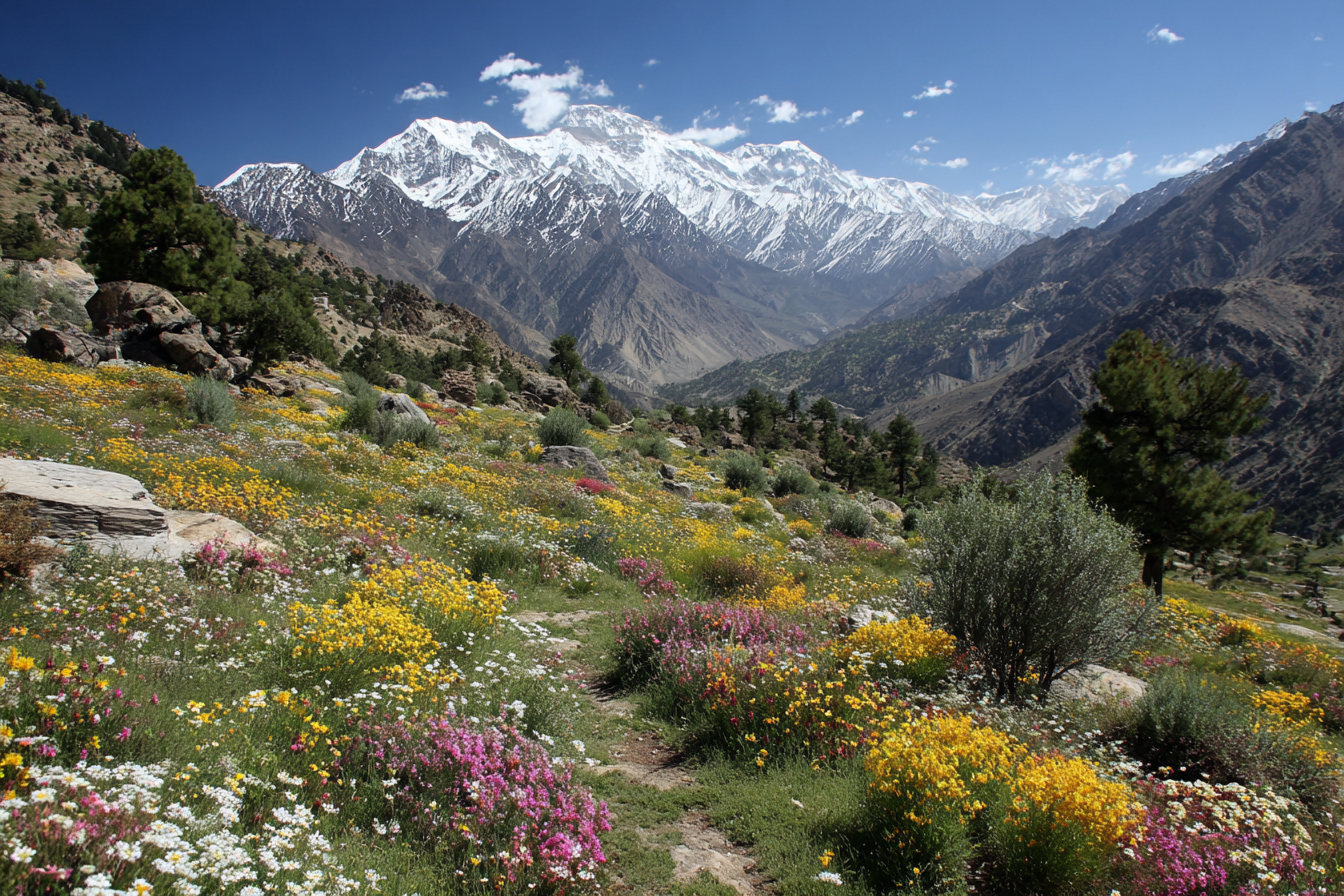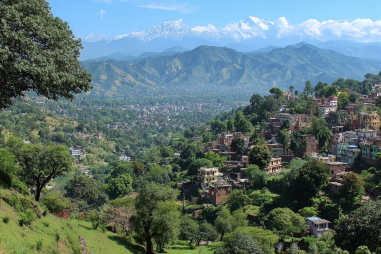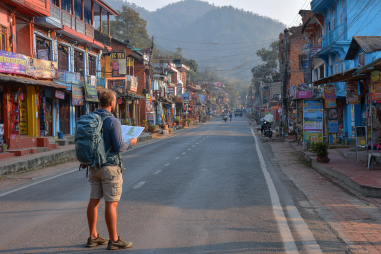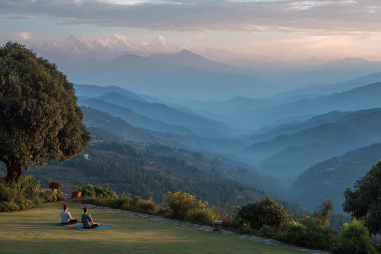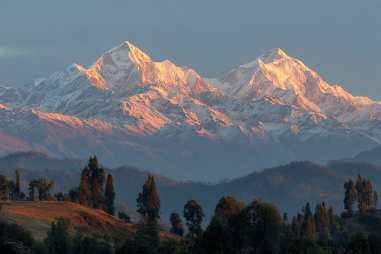Jomsom, nestled in the heart of Nepal’s Mustang region, is a treasure trove of natural beauty and biodiversity. Situated at a high altitude in the Himalayas, this area is home to a variety of unique plants and animals that have adapted to thrive in its rugged and often harsh environment. Whether you’re a seasoned naturalist or a casual traveler with an interest in nature, exploring Jomsom’s flora and fauna offers a fascinating glimpse into life above the clouds. This guide will help you discover the remarkable biodiversity of the region, highlighting key species and offering tips to experience this natural heritage responsibly.
Jomsom’s Unique Natural Environment
The environment around Jomsom is characterized by its high-altitude semi-arid climate, situated roughly between 2,700 and 3,200 meters above sea level. The landscape is diverse, featuring rocky slopes, deep gorges, and terraced fields, with the majestic Annapurna and Dhaulagiri mountain ranges providing a dramatic backdrop. Due to the rain shadow effect created by these towering peaks, Jomsom receives relatively low rainfall, leading to dry conditions that significantly influence both plant and animal life.
This combination of altitude, temperature variation, and moisture scarcity has led to ecosystems that are unique and specialized. Here, species have evolved remarkable adaptations to survive, making Jomsom an exceptional area for studying high-altitude biodiversity. The region’s natural environment supports everything from hardy shrubs and alpine flowers to elusive mammals and a surprising variety of birdlife.
Common and Rare Plants of Jomsom
The flora of Jomsom reflects its high-altitude, semi-arid conditions. During the warmer months, the hillsides burst into color with a variety of wildflowers and shrubs adapted to the rocky terrain and limited water availability. Among the commonly spotted plants are:
- Rhododendrons: Nepal’s national flower, these bright pink, red, or white blooms appear in spring and are a stunning sight amidst the otherwise grey-brown landscape.
- Juniper bushes: These aromatic shrubs are widespread and have cultural significance, often used locally for incense and medicinal purposes.
- Bermuda grass and local herbs: These tough, drought-resistant species cover many slopes and grazing lands.
In addition to these common species, Jomsom’s flora includes rarer alpine plants that thrive above the tree line. These include various types of alpine asters, edelweiss, and medicinal plants such as the Himalayan aconite. The presence of these plants indicates a delicate balance in the ecosystem, as many of these species are sensitive to climate changes and human disturbance.
Wildlife Species Seen Around Jomsom
Although the area’s dry and rugged environment might seem inhospitable at first glance, Jomsom supports a surprising range of wildlife. Mammals here are generally elusive, adapted to the steep terrain and sparse vegetation, but with patience, you can spot some remarkable species.
- Himalayan tahr: A wild goat with thick fur that blends perfectly with the rocky surroundings. They are often seen grazing on the mountain slopes early in the morning or late afternoon.
- Blue sheep (bharal): These nimble herbivores are a common sight in the Mustang region and are well-adapted to steep cliffs.
- Snow leopard: Although extremely elusive and rarely seen, the snow leopard is native to these higher altitudes, symbolizing the wild mystery of the Himalayas.
- Red fox and Himalayan marmot: Smaller mammals that can be spotted with some effort near grassy meadows and rocky crevices.
The diversity of animals here offers nature enthusiasts a chance to observe species that are often difficult to find elsewhere, especially those adapted to high-altitude conditions.
Birdwatching Highlights in Jomsom
Birdwatchers visiting Jomsom are in for a treat. The diverse habitats and altitude gradients create an excellent environment for both resident and migratory birds. Some notable bird species include:
- Lammergeier (Bearded vulture): This impressive bird of prey, with its enormous wingspan and scavenging habits, is a highlight for many visitors.
- Wallcreeper: A small and striking bird, famous for creeping along the vertical cliffs and displaying vivid red wings.
- Snow pigeon: Often seen in flocks, these pigeons are adapted to cold highland areas.
- Himalayan griffon vulture: Another large scavenger, important for the ecosystem’s cleanliness.
- Various waterfowl along the Kali Gandaki River: The river valley supports ducks, herons, and other birds at lower elevations.
Birdwatching in Jomsom is rewarding throughout the year, though spring and early autumn tend to be especially productive periods, with migratory species passing through or settling temporarily.
Conservation Status and Protected Areas
The biodiversity of Jomsom is part of a broader conservation landscape in Mustang and the Annapurna region. Efforts to protect the area’s flora and fauna include community-based conservation initiatives that encourage sustainable tourism and habitat preservation.
Jomsom lies close to the Annapurna Conservation Area, Nepal’s largest protected area, which has been instrumental in conserving habitats for many species. This area emphasizes the integration of local communities’ livelihoods with environmental stewardship, helping to restrict activities like overgrazing, illegal logging, and poaching.
However, challenges remain. Climate change, increasing tourism, and infrastructure development pose risks to fragile habitats. Continued conservation enforcement and responsible tourism are vital to safeguarding the region’s natural heritage for future generations.
Tips for Responsible Wildlife Observation
For travelers interested in exploring Jomsom’s rich biodiversity, observing wildlife responsibly is essential. Here are some practical tips:
- Keep a respectful distance: Use binoculars or zoom lenses rather than approaching animals closely.
- Follow marked trails: Avoid damaging plants or disturbing wildlife habitats by sticking to established paths.
- Minimize noise: Speak softly and move slowly to avoid startling animals and birds.
- Don’t feed wildlife: Human food can harm animals and alter their natural behaviors.
- Respect local regulations: Obey park rules and guidelines set by conservation authorities and community organizations.
- Leave no trace: Carry out all your trash and avoid collecting plants or animals.
By adopting these practices, you not only enhance your experience but also contribute to preserving Jomsom’s ecosystems.
Seasonal Variations in Biodiversity
Jomsom’s biodiversity changes with the seasons, influenced by temperature fluctuations and precipitation patterns. Understanding these variations can enhance your visit:
- Spring (March to May): A prime time for flora, with rhododendrons and wildflowers blooming. Migratory birds begin to arrive, and mammals become more active after winter.
- Summer (June to August): Although this period is warmer, Jomsom remains drier than lower elevation areas. You’ll find lush grasses and herbs, but some trails may be less accessible during monsoon rains in surrounding regions.
- Autumn (September to November): Clear skies and mild weather support excellent birdwatching and wildlife viewing. This is also the harvest season for local crops, with changing landscapes adding color and vitality.
- Winter (December to February): Harsh, cold conditions lead to reduced visible wildlife activity. Some animals hibernate or move to lower elevations, making sightings scarce but highlighting the resilience of high-altitude species.
Choosing the right season based on your interests will maximize your experience of Jomsom’s natural wonders.
Embracing Jomsom’s Natural Heritage
Exploring the flora and fauna of Jomsom offers a unique opportunity to connect deeply with one of the world’s most striking high-altitude environments. The delicate balance of its ecosystems, the stunning variety of plants and animals, and the peaceful, open landscapes all contribute to an unforgettable experience. Whether you are trekking along the Kali Gandaki river, birdwatching on a rocky slope, or simply soaking in the views of the snow-capped Himalayas, you become part of a living natural tapestry shaped by resilience and adaptation.
By learning about and respecting Jomsom’s natural environment, visitors can help ensure that this remarkable biodiversity continues to thrive. In doing so, you’ll carry away not just memories of majestic scenery but also a profound appreciation for the wonders of nature that unfold quietly at the roof of the world.

